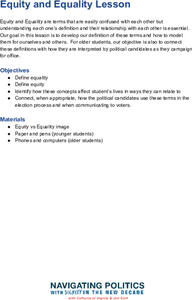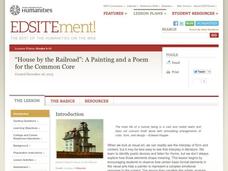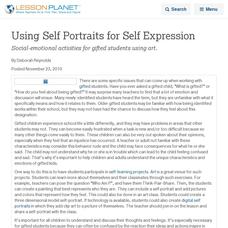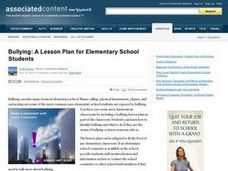Department of Education (Ireland)
Consequences
11 lessons, designed to be used in consecutive order, ask middle and high school scholars to consider the effects of various drugs and the consequences of taking them for themselves and their families. They also develop the communication...
Cultures of Dignity
Equity and Equality Lesson
Equality does not equal equity and this lesson explains why. Class members compare two images--one labeled "Equality" and the other "Equity." Using the provided discussion questions, they then develop definitions that distinguish between...
Curated OER
Paint With Expression!
Learners identify the moods expressed in the work of several famous artists. They express an emotion in a painting through the use of color, line, and texture. Students analyze and reflect on the emotions expressed in their work and the...
Curated OER
Touching Tissue
Students create a multimedia collage. They identify strong personal emotions related to an event in their lives and describe them with several words. They choose symbols that are related to their emotions and arrange these symbols in an...
Curated OER
Identity, Belonging, and Social Inclusion
Students explore personal and social identity. In this character education instructional activity, students create identity profiles and design welcome plans for their school community in order to build personal and community identities.
Curated OER
Courage: Hero Traits
What does it mean to be a hero? Who qualifies as a hero? In groups, middle and high schoolers brainstorm a list of heroes and create a list of characteristics that a person must possess in order to be a hero. Extend this lesson by having...
Curated OER
Our Successful Traits
Young scholars brainstorm and discuss essential traits for success. They develop a group list that displays essential traits of the successful classroom and journal about the experience.
Curated OER
Cultivating Caring - Filling Buckets of Caring Carrots
Learners practice compassion. In this character education lesson plan, student read Have You Filled a Bucket Today? by Carol McCloud. Students discuss the book as well as ways to demonstrate they care for one another. Learners fill...
National Endowment for the Humanities
“House by the Railroad”: A Painting and a Poem for the Common Core
Introduce your class to ekphrastic poetry with an exercise that asks them to examine Edward Hooper's painting House by the Railroad and Edward Hirsch's poem "Edward Hopper and the House By the Railroad." After a close reading of the two...
Curated OER
Japanese Noh Masks
Students examine Japanese theatre and create their own face masks which display certain emotions, props, costumes and perform in improvisational theatrical games.
Curated OER
The Choir
In this music worksheet, students read an excerpt about the choir, the oldest of all musical groups. They identify that human voices vary in pitch, some high and some low, making it possible to sing harmonies in different layers.
Curated OER
Taking on a Task
Eighth graders identify ways to persevere. In this character education lesson, 8th graders work in small groups to complete a task using strategies to persevere.
Curated OER
Don't Give Up
Eighth graders demonstrate perseverance. In this character education lesson, 8th graders define the word perseverance and identify difficult tasks they face regularly which require perseverance.
Curated OER
Growing on My Own, Kids on the Grow
Students participate in an after school program that promotes critical thinking, concern for others, recognizing differences, accepting differences, self-motivation and personal safety. They cover how kids develop, expressing different...
Curated OER
Human Development
High schoolers brainstorm about the physical, emotional, and social developmental milestones of human beings. They complete a timeline as a class that begins with birth and ends with death. Students identify whether each milestone is...
Curated OER
EXPRESSIONIST ART LESSON
Sixth graders design and compose a picture that conveys a specific emotion or feeling, and recognize the use of emotion in a variety of artworks using crayons and/or pastels. They experiment and manipulate elements of art including, line...
Curated OER
Poetry of Abraham Lincoln
Fourth graders analyze Abraham Lincoln's poems "The Bear Hunt" and "My Childhood's Home" for word choice and deeper inquiry into the vocabulary he uses to convey emotion. They identify rhyming words and patterns in these poems. ...
Curated OER
Using Self Portraits for Self Expression
Social-emotional activities for gifted students using art.
Curated OER
Dance: Personal Soundtracks
Students create a musical autobiography. For this fine arts lesson, students explore the emotions that music can express by listening to and discussing a variety of music. Students construct a personal timeline and a collection of music...
Curated OER
The Influence of Jazz Music in Twentieth Century Art
Students examine the effect of music on society. While listening to music, they identify the beat, rhythm and write down their reaction to it. Listening to longer selections, they assign a color to the music and share it with the...
Curated OER
Circle Justice—Lesson 1: The Anger Within
Learners examine the emotion of anger through the poem 'A Poison Tree'. In this poetry analysis lesson, students identify and decode unfamiliar vocabulary they encounter, engage in groups discussions and complete several writing...
Curated OER
Creating Characters
Students examine the methods of effective characterization. In this writing skills lesson, students discuss how emotions, dialogue, actions, and physical descriptions build believable characters. Students then use the methods of...
Curated OER
A Lesson Plan for Elementary School Students
Students identify characteristics of verbal, physical, emotional and cyberbullying. In this bullying instructional activity, students gather information about bullying and work in discussion groups to find ways to report and combat...
Curated OER
How Media Shapes Perception
Students explain the impact that the media may have in shaping their intellectual and emotional responses to current events. They examine broadcast and Web-based news sites to find subtexts through the use of language, audio, and visual...

























